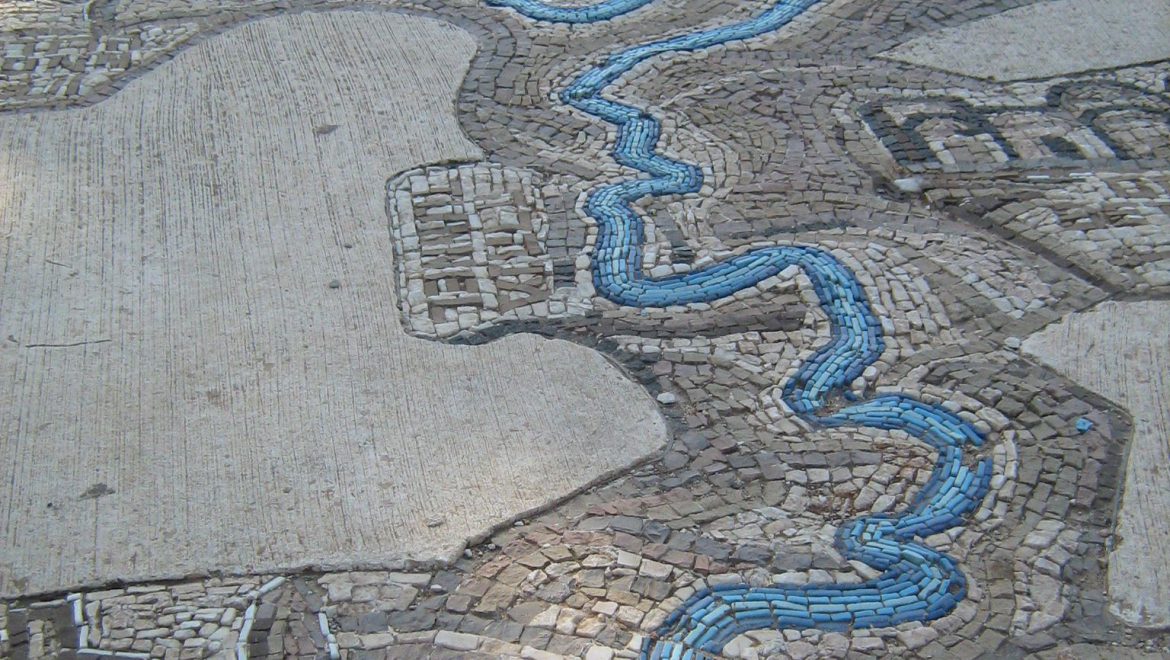
The Hasmonean Aqueduct Tunnel in Armon Hanatziv
The Armon Hanatziv Promenade offers one of the best views of Jerusalem and is one of the city’s most romantic spots. Below the promenade, there is a 2000 year old aqueduct that conveyed water to the Temple Mount in the days of the 2nd Temple and continued to do so until the end of the 19th century.
There is a new mosaic that tells the story of the Jerusalem aqueducts in the Meir Sherman Garden a short walk away from the Armon Hanatziv Promenade. The impressive mosaic, near the enormous Jean Arp sculpture in the park, depicts the course of the aqueduct system whereby the Biyar and Arrub aqueducts conveyed water from the south of Bethlehem to the Solomon Pools, and from there two other aqueducts, the High-Level and the Low-Level aqueducts, conveyed the water to Jerusalem.
The High-Level Aqueduct was 8 miles long. It passed via the Mar Elias Monastery and Gilo Junction and continued westward to Kibbutz Ramat Rachel, on to the Valley of Rephaim, the Jaffa Gate and Hezekiah’s Pool near the Church of the Holy Sepulchre.
The aqueduct, which conveyed the water according to the communicating vessels principle with a very sophisticated 2000 years old engineering system, is renowned for its impressive stone pipes, part of which can still be seen today across a valley near Rachel’s Tomb.
The Low-Level Aqueduct is right underneath us and can be visited. It is about 12.5 miles long although the distance between Bethlehem and the Solomon Pools is less that 6 miles, and it ends at an area on the Temple Mount that is pockmarked with about 30 water reservoirs, built at the time of Jesus and King Herod.
On the route from the Solomon Pools there were three obstacles: the Sur Baher hills, the Armon Hanatziv ridge and Bethlehem. The Romans found a solution for two out of the three places: they dug tunnels in order to transfer the water. The Bethlehem tunnel is 400 yards long, and the Armon Hanatziv one is 460 yards long.
The precise design and the moderate incline are considered, even today, to be very complicated to execute. The aqueduct was built in the Roman era with piers and arches as foundations, with the six piers at a distance of 50 yards from one another. They dug from both ends of the rock in order to connect to the piers because that helped them to find their directions and also because it enabled them to get some air and light.
You can see the big pier that connects to the tunnel below us in the center of the mosaic. The Jerusalem Municipality chose this site to display the mosaic because the tunnel and the pier are directly underneath. We will now go and see the pier.
Into the tunnel
It is only a short walk from the site of the mosaic to the valley below. If you have made the required advance reservations, someone will open the gate to let you in to the site, which is managed by those who manage the City of David. The original height of the tunnel was about 5 feet, but luckily the Ottomans expanded it, thereby not necessitating people to crawl through the tunnel.
The pipes inside the tunnel are cement-covered ceramic pipes built by the Ottomans. If a pipe got blocked, they had to drill holes into it in order to clean it. About 100 years ago, the Turks decided to cover the aqueduct in plaster and to insert iron pipes from here to the Dung Gate and the Temple Mount, as well as to the Sultans Pool.
From the very beginning of the tunnel you can see stones plates overhead. Other than the pipes and the piers, there are signs indicating how far you’ve come and how far you still have to go. At the end of the tunnel, there is an impressive gabled roof.


